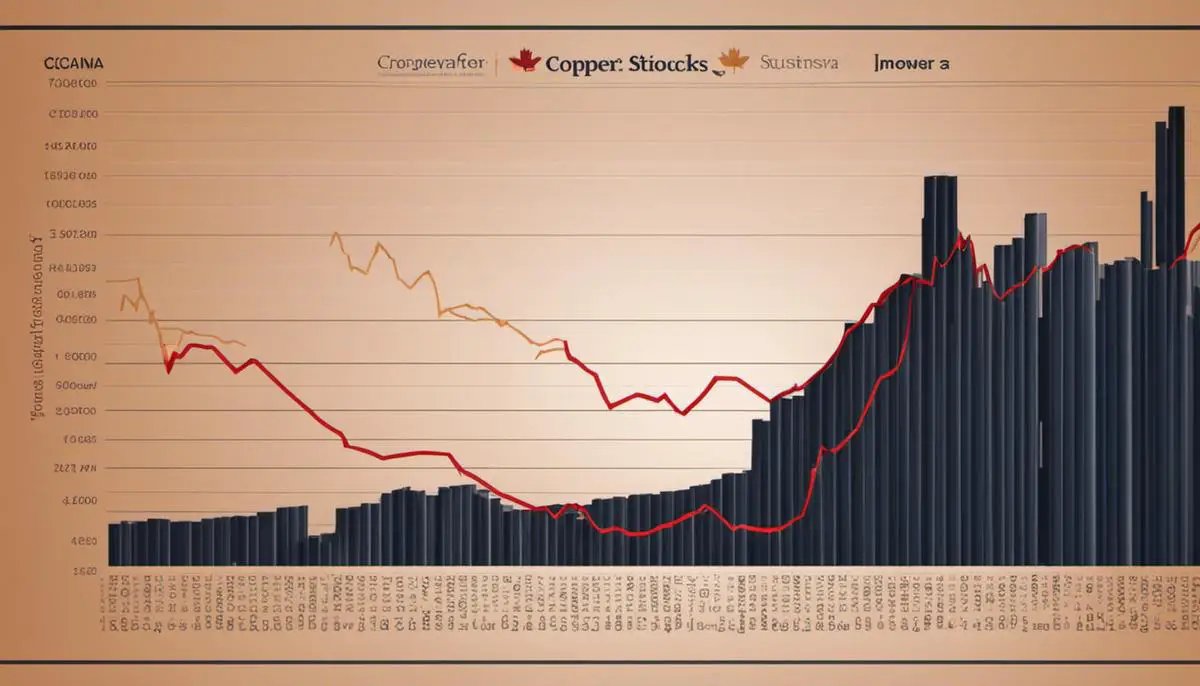Undeniably, Canada’s copper industry holds a position of both historical and economic significance within the framework of the nation’s economy. With a rich geological landscape yielding a wealth of this critical industrial metal, Canada stands as an epicentre of copper mining, production, and trade. As the industry continues to evolve, riding the waves of fluctuating commodity prices, regulatory shifts, and global economic changes, the landscape of copper stocks offers a tempting prospect for investors.
This article delves into the intricate dynamics of copper stocks within Canada, outlining a comprehensive overview of the sector, exploring viable investment strategies, critically analyzing major copper stocks and their market positioning, and casting a future-forward glance at copper production and demand forecast. Of equal importance, the essay unravels the impact of geopolitical events on copper stocks, hence offering a 360-degree view of the Canadian copper investment landscape.
What's in the Article:
Overview of the Canadian Copper Industry
Canadian Copper Industry Overview
Canada’s copper industry is pivotal in its economy, contributing significantly to its GDP. The nation is one of the top-rated global miners of this red metal, second only to Chile in terms of copper production. It is an industry with substantial economic viability due to the vast deposits of copper ores scattered across the country. It is projected to boost economic growth in the future, even amidst price fluctuations.
The country’s copper mines are mainly located in British Columbia, and some significant ones can be found in Ontario, Quebec, and Manitoba. Overall, the industry generates a considerable number of jobs, adds to the country’s economy, and consequently impacts Canada’s copper stocks.
Regulatory Framework of the Copper Industry
The copper industry in Canada operates under a regulated framework that maintains a consistent management approach and ensures its continued and sustainable growth. The industry policies developed by the federal, provincial, and territorial governments specifically look toward sustainable mineral resource development. These regulations address issues of environmental concern, indigenous property rights, and the economic benefits for communities impacted by the mining industries.
This sector is under the jurisdiction of the Canadian Environmental Protection Act (CEPA) and the Metal Mining Effluent Regulations (MMER) under the Fisheries Act, which ensures that the operations are environmentally safe and sustainable.
Major Players in the Copper Industry
The Canadian copper industry comprises several key players, with the likes of Lundin Mining Corporation, First Quantum Minerals Ltd, and Teck Resources Limited leading the charge. These companies significantly influence the industry dynamics and, by extension, the performance of Canada’s copper stocks.
Lundin Mining Corporation, known for its operational efficiency, has undertaken major expansions to increase its copper production capacity. Similarly, First Quantum Minerals Ltd is planning significant growth in copper mining, backed by their large reserve base. Teck Resources Limited, a diversified resource company, engages in copper mining, among other things, and adds a considerable amount of supply to the global market.
Impact of Global Economy and Commodity Prices
The performance of the global economy can greatly impact commodity prices and, consequently, the copper industry and its stocks. In global economic growth periods, copper demand usually rises due to increased manufacturing and construction activities. This, in turn, leads to higher copper prices, positively affecting Canada’s copper industry and its stocks.
Conversely, in periods of economic downturn, the demand for copper decreases, dragging down prices and negatively impacting the industry. The recent COVID-19 pandemic has been a striking example of this; with the slowdown of global economic activities, there was a significant drop in copper prices, which affected the operations and returns of the major copper players in Canada.
Regulatory Implications and Copper Stocks in Canada
Government regulations wield impactful sway over the copper sector. Elements like environmental regulations, native rights, import and export laws, royalty fees, and taxation policies all have a hand in shaping how industry leaders conduct operations. This, in turn, impacts copper stocks; compounded environmental regulations, for instance, can elevate operational costs, shrink profits, and ultimately result in a downturn in copper stocks.
To fully grasp the dynamics of Canada’s copper stocks, it’s key that potential investors understand the interaction of domestic regulatory structures, global economic dynamics, and commodity pricing. This understanding is fundamental for anyone looking to profit from investing in Canada’s copper industry.
What are the best copper stocks in Canada?
Here are 10 Canadian copper stocks that offer potential exposure to the copper industry in Canada:
First Quantum Minerals Ltd.
Symbol: FM.TO
Market Cap: $19.81 billion
Brief: Established in 1983, it is the world’s sixth-largest copper producer and operates in nine countries. The company has a five-year plan to reach 1 million tonnes of copper produced annually.
Teck Resources Ltd.
Symbol: TECK.B.TO
Market Cap: $28.41 billion
Brief: Established in 1906, Teck Resources operates in several industries, with copper making up 23% of its portfolio. It plans to increase the copper allocation in its portfolio in the coming years.
Ivanhoe Mines Ltd
Symbol: IVN.TO
Market Cap: $13.90 billion
Brief: Based in Vancouver, its Kamoa-Kakula site in the Democratic Republic of Congo is set to become the world’s third-largest copper project by 2024.
Lundin Mining Corp.
Symbol: LUN.TO
Market Cap: $6.59 billion
Brief: Founded in 1994, Lundin operates six copper mining projects globally. Copper consists of 69% of Lundin’s resource portfolio.
Hudbay Minerals Ltd
Symbol: HBM.TO
Market Cap: $1.78 billion
Brief: Founded in 1927, Hudbay has several projects in operations and exploration across the US, Canada, and Peru. 60% of its revenues come from copper.
Capstone Mining Inc.
Symbol: CS.TO
Market Cap: $4.20 billion
Brief: Established in 1987, Capstone has five project locations globally. It recently combined with Mantos Copper.
Ero Copper Corp
Symbol: ERO.TO
Market Cap: $2.0 billion
Brief: Founded in 2016, Ero Copper operates entirely in Brazil and is on pace to double its copper mining capacity by 2025.
Copper Mountain Mining Corp
Symbol: CMMC.TO
Market Cap: $478.58 million
Brief: Founded in 2006, it operates the Copper Mountain Mine in Canada and the Eva Copper Project in Australia.
Filo Mining Corp
Symbol: FIL.TO
Market Cap: $2.52 billion
Brief: Founded in 2016, Filo Mining has an average annual production level of 67 kt of copper. The stock has returned 801% over the past five years.
Taseko Mines Ltd
Symbol: TKO.TO
Market Cap: $666 million
Brief: Founded in 1999, Taseko operates four copper projects in British Columbia and one in Arizona. It has over 15 billion pounds of copper reserves.
These companies have been selected based on their financial performance, market position, and growth potential.
Investment Strategies for Copper Stocks
The Fundamentals: Investing in Canada’s Copper Stocks
Copper is considered a staple in understanding global economic health, given its integral role in industries such as construction and manufacturing. Hence, the demand for this metal often mirrors the well-being of these sectors.
As host to some of the planet’s most lucrative copper mines, Canada’s copper stocks are a magnet for international investors, particularly those with a keen interest in commodities.
Long-Term Investments
Long-term investment can be a viable strategy for investing in copper stocks. In this, the long-term cycle of copper prices is key. Copper is a commodity that tends to enjoy boom periods followed by busts. Demand for copper tends to grow over the long term due to its integral role in various industries like manufacturing, telecoms, and electrical goods. Investments during periods of low prices, keeping a longer time horizon in mind, can lead to significant gains over time.
Short-Term Trading
Short-term trading is another strategy that can be employed for copper stocks. This involves buying stocks when the price is low and selling them when the price increases within a short time frame. However, one must remember that copper prices can be highly volatile and influenced by a range of factors, including global economic trends, geopolitical tensions, and overall market sentiment, requiring careful analysis and risk management.
Diversification
Diversification is a strategy recommended for almost any investment, including copper stocks. It involves spreading your investments across multiple stocks or commodities to reduce risk. Given the volatile nature of copper prices, it is prudent to diversify your portfolio to include copper stocks and other commodities or different asset classes.
Investment in Copper ETFs
Exchange-traded funds (ETFs) offer a convenient way to invest in a diverse range of copper stocks without buying each stock individually. Copper ETFs track the price of copper or an index of copper stocks, allowing investors to gain exposure without the complexities of the futures market. Such ETFs are listed on major exchanges, providing liquidity and flexibility to investors.
Managing Risks in Copper Investments
For any investment, adhering to risk management practices is crucial, even more so when dealing with copper stocks, due to the several global factors influencing copper prices, causing them to be highly volatile.
The core of effective risk management involves setting precise investment objectives, diversifying your portfolio, staying current with market trends, and keeping an eye on worldwide economic developments. Implementing stop-loss orders is another efficient way to manage risk by setting a predefined selling price that limits your investment losses to an acceptable level.
The complexity and dynamics of the copper market make it essential for investors to have a consistent risk management strategy. This approach aids in maintaining resilience across various market conditions, at the same time ensuring losses are kept to a minimum.
It is also beneficial to keep track of the performance and trends of leading copper mining companies in Canada, such as First Quantum Minerals, Lundin Mining Corporation, and Turquoise Hill Resources, to assist with informed decision-making.
When applied appropriately, these strategies can facilitate successful investments in Canada’s copper stocks, offering promising returns while limiting associated risks.
Analyzing Major Copper Stocks in Canada
Deciphering the World of Copper Stocks
Copper stocks are fundamentally tied to companies primarily exploring, extracting, and producing copper. These stocks are popular among investors due to the wide-ranging applications of copper in several sectors like construction, electrical equipment, transport, and industrial machinery. The fluctuating cost of copper usually influences the value of copper stocks. Prominent contributors to the global copper market from Canada include companies such as First Quantum Minerals, Lundin Mining Corporation, and Turquoise Hill Resources.
Evaluating Financial Performance
Investors should consider various factors when looking into the financial performance of copper stocks. This includes revenue and earnings trends, working capital, debt levels, and cash flow. Additionally, profitability ratios such as return on equity, return on assets, and net profit margin are indicators of a company’s ability to generate profits from its operations. Another essential financial analysis consideration is comparing these metrics with industry peers to understand where the company stands in the competitive landscape.
Management and Strategic Growth Plans
Another integral aspect of evaluating copper stocks is assessing the firm’s management team. This includes their experience, track record in delivering results, and strategic vision for the company. The company’s growth strategies, such as expansion into new markets, acquisitions, partnerships, and product innovation, provide insight into future prospects. Investors should take note of the viability of these plans and their potential impact on the company’s financial performance.
Market Positioning
Market positioning is another critical factor in stock analysis. It refers to how a company positions itself relative to its competitors in the market. Having a competitive edge in terms of cost, quality, or technology will influence the company’s market share and profitability. Investors should also consider the copper market dynamics. For instance, companies with large copper reserves are typically more appealing than those with smaller reserves.
Understanding Key Performance Indicators
Investors evaluating copper stocks should understand key performance indicators (KPIs) relevant to the mining industry. These include the average realized price of copper, cash costs per pound, all-in-sustaining costs, and the total amount of copper reserves and resources. In particular, lower cash costs per pound and all-in-sustaining costs indicate a company’s efficiency, while the average realized copper price can signal profitability.
The Impact of Copper Prices
The performance of copper stocks is often tied to copper prices, which are influenced by supply-and-demand dynamics. For instance, increased global economic activity generally leads to higher demand for copper, boosting copper prices and thus enhancing the profitability of copper mining companies. Conversely, any factors causing a decrease in industrial demand or an excess in copper supply can lead to a fall in copper prices, impacting the revenue and profitability of copper mining firms.
Canadian Copper Companies
Among Canadian copper stocks, some noteworthy names include First Quantum Minerals Ltd., one of the fastest-growing copper miners globally; Lundin Mining Corporation, known for its high-quality base metal deposits; and Turquoise Hill Resources, which operates one of the world’s largest copper-gold-silver mines. These companies’ performance reflects the health of Canada’s copper industry and its prospects, with their stocks offering attractive opportunities for investors keen on gaining exposure to the copper market.
Regulatory Influence
It’s essential to recognize that the regulatory framework can drastically impact the performance of copper stocks. Elements such as Canadian mining legislation, environmental protocols, and international trade pacts are all pivotal in estimating operational expenditure and determining the economic viability of such companies. Investors need to stay abreast of any fluctuations or adaptations within this legislative environment to discern impending difficulties or prospects for their investments in copper stocks.
Copper Production and Demand Forecast
Assessing the Global Copper Production Scene
With an array of applications spanning industries such as construction, electrical equipment, and transportation, copper has been cited as one of the pivotal metals globally. A vast segment of worldwide copper output stems from large copper mines situated in countries including Chile, Peru, and the United States. Although Canada may not be the most prodigious, its contributions to global copper production should not be undervalued, as it holds its position within the top ten producers worldwide. Hence, Canada’s role in copper production is noteworthy in global copper supply and demand dynamics discussions.
Impact on Canadian Copper Stocks
Given the importance of copper usage worldwide, trends in its demand and supply directly impact Canadian copper stocks. Mining companies with large copper operations in Canada, such as First Quantum, Lundin Mining, and Teck Resources, are directly influenced by movements in global copper prices. Generally, higher copper prices would translate into higher revenues and potentially higher stock prices for these companies. Therefore, understanding the forces driving global copper supply and demand becomes crucial for investors interested in Canadian copper stocks.
Factors Affecting Copper Production Costs
Many factors influence copper production costs. These include operating expenses, capital expenditure, royalties and taxes, and factors such as the quality of a mine’s ore deposits and the efficiency of its operations. Copper prices fluctuate with changes in these costs, in turn affecting the performance of copper stocks. For instance, a rise in fuel costs or a decline in ore grades could increase mining costs, prompting a rise in copper prices and positively impacting Canadian copper stocks.
Changing Demand Patterns
With advancements in technology, copper’s role has evolved over time. Today, it plays a significant role in green technologies such as electric vehicles and renewable energy systems, which require large amounts of copper for manufacturing. Consequently, the global demand for copper is expected to rise as these technologies become increasingly prevalent. This rising demand, alongside limited supply, may result in increased copper prices and potential benefits for Canadian copper stocks.
Copper: A Future Outlook
The future outlook for copper appears optimistic. Analysts predict that the rise in green technology usage and ongoing urbanization in developing countries will continue to drive global copper demand. This anticipated growth in demand may outpace the already stringent copper supply, putting further upward pressure on prices. Consequently, this could translate into improved performance for Canadian copper stocks.
Role of Infrastructural Development in Demand
Furthermore, the demand for copper is expected to increase due to its vital role in infrastructural development. The ongoing transition towards renewable energy targets and infrastructure expansion in growing economies suggests a positive future for copper. This growth trajectory alone could provide a substantial boost to Canadian copper stocks.
A compelling understanding of the copper industry, including potential risks such as production fluctuations due to labour strikes, operational issues, or significant consumption shifts, is paramount for investors of Canadian copper stocks. Being mindful of these factors will not just enhance your grasp of the supply and demand dynamics of copper. Still, it will also strategically position you to maximize potential profits from your investments within this sector.
Impact of Geopolitical Events on Copper Stocks
The Intricacies of Copper Prices: Influence of Geopolitical Events
Geopolitical events and tensions worldwide, ranging from international trade disputes to policy shifts among key economies, can significantly impact copper prices. For instance, changes in China’s fiscal policies and external politics, as a substantial copper consumer, can trigger considerable variations in global copper prices.
Alongside the global landscape, domestic geopolitical matters within copper-producing nations might pose profound implications. In times of political uncertainty or conflict, the assurance of copper supply may waver, accordingly influencing prices based on the perceived alterations in the supply-demand balance.
Interplay between Canadian Copper Stocks and Geopolitical Events
Canadian copper stocks are intertwined with these global occurrences. As a major contributor to the Canadian mining industry, shifts in copper prices directly reflect upon the performance of these stocks. Numerous firms’ value and future predictions rely heavily upon global copper pricing, rendering them vulnerable to international geopolitical fluxes.
Essentially, investors of Canadian copper stocks must maintain an insight into worldwide events beyond the confines of Canada. One notable example lies in the trade policy changes by the Trump administration, which led to considerable shifts in commodity prices, subsequently influencing copper prices and stocks.
Economic Opportunities Amidst Geopolitical Events
While these geopolitical events could lead to potential risk and unpredictability, adept investors can strategically capitalize on them. By meticulously monitoring global news, investors can anticipate plausible shifts in copper prices, consequently adjusting their investment strategies.
In this scenario, educated investors might leverage predictive analytics and strategic tools to anticipate possible price trends in response to geopolitical changes. Though challenging, this approach can empower them to make informed decisions about acquiring, retaining, or offloading copper stocks.
Zooming in on Canadian Copper Stock Investments
The robustness of Canada’s copper industry, coupled with the ambiguity of global geopolitical events, implicates potential risks and chances for investors. A deep understanding of global influences on copper prices is therefore indispensable for anyone considering an investment in Canadian copper stocks.
Due to the country’s extensive copper reserves, investments in Canadian copper stocks carry considerable weight. As the third-largest copper producer worldwide, significant mining activities occur in British Columbia, Quebec and Ontario. Any global political or economic shifts that mould the copper market could directly affect these regions and, by extension, Canadian copper stocks.
With an updated awareness of global occurrences and their potential impact on copper prices, astute Canadian copper stock investors can make well-informed and prompt decisions. This strategy can help curb potential risks and take advantage of arising opportunities within a frequently fluctuating geopolitical landscape.
A profound understanding of Canada’s copper industry and strategic investment approaches can unlock significant value for investors. The analysis of major copper stocks in the market, combined with a keen eye on the shifting dynamics of supply and demand, must form the core of any investment strategy. Likewise, understanding the impact of geopolitical factors on copper prices becomes an indispensable skill for investors seeking to capitalize on these often unexpected market fluctuations. As the world continues to embrace technological advancements and shifts towards a greener economy, the demand for copper is anticipated to surge. Thus, with the correct information and strategic approach, Canadian copper stocks present a rewarding investment opportunity and offer a unique vantage point to observe and understand the interconnected global economy.




